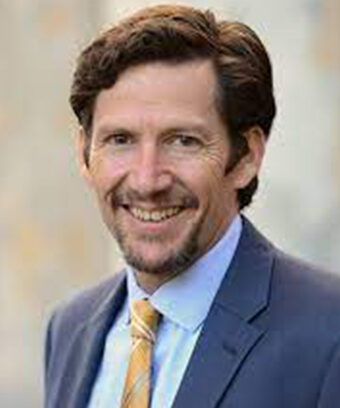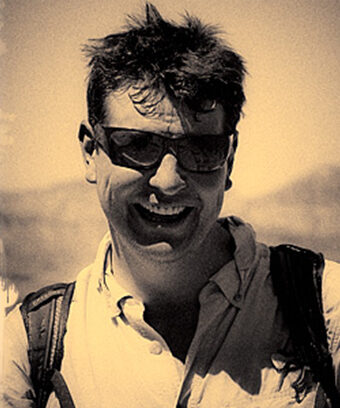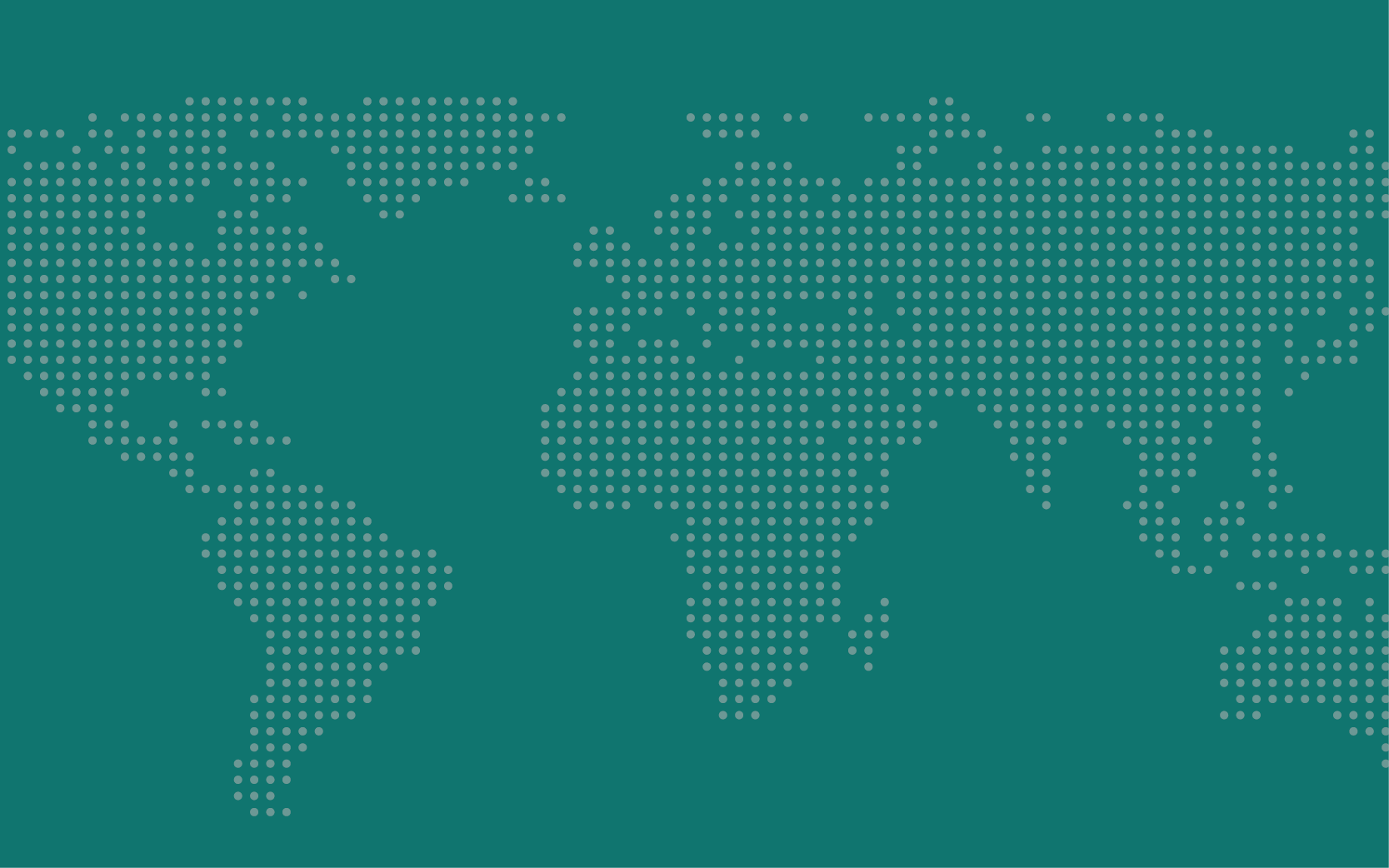Ukraine One Year After the Invasion
Russia’s war in Ukraine will soon enter its second year. The war continues to cause destruction both in and beyond Ukraine and is challenging assumptions about the world among policymakers and ordinary citizens alike. In this collection, experts from across the University of California share how their thinking about the war and its consequences is evolving.
Jump to a specific topic:
- Daniel Brunstetter on Teaching about War during the Russia-Ukraine Conflict
- Tai Ming Cheung on the Coming Together of Russia and China
- Bridget Coggins on Ukraine and the Contestation of International Norms
- Paul D’Anieri on the Continued Surprises of the War
- Jana Grittersova on the Disappointment of Sanctions
- James Lee on What Ukraine Means for Taiwan
- Jess Peake on Why Creating a New Tribunal to Prosecute Russian Aggression Is a Bad Idea
- Andrew Reddie on the Strategic Implications of the War
- Christina Schneider on Why Ukraine is a Watershed Moment for Europe
- Andrew Shaver on the Humanitarian Implications of the War
- Branislav Slantchev on Miscalculations, Surprises, and What Is At Stake for the World
- Scott Tait on What the West Should Do

Daniel Brunstetter on Teaching about War during the Russia-Ukraine Conflict
I routinely teach a fall undergraduate class called “Just War Revisited” at UC Irvine—”just,” as in moral, war. On the first day of class, I ask students if they believe war could ever be justified. We go through the wars from World War II to the present, one by one. Afghanistan and Iraq, Gaza, Lebanon, the U.S. drone wars, Georgia, Libya, Syria, Yemen, Ethiopia, the conflict against ISIS in Iraq and Syria. (These are just since 2006, when I began teaching.) Each of these wars has animated past syllabi, but the urge to keep the discussion current means that new wars replace old ones each year. The conflict dominating the class now is the Russian war of aggression against Ukraine.
Most students do not identify as pacifists. But though the idea of “just war” shot into primetime when President Obama famously used the term in his 2009 Nobel Prize speech, students hesitate to embrace the concept. They see it through the lens of American wars fought afar during their lifetime, and express concern that calling war “just” can mask imperial intentions, that even “just” wars can be fought unjustly, and that none of the “just” wars fought recently have brought stable peace.
Has the Ukraine-Russia conflict fueled these perennial doubts? Or has it re-enforced the inkling that there might be something called a just war—that morality does indeed have a place in international affairs?
In November 2021, I gave a lecture about the Russia-Ukraine situation, when it seemed incredulous to think that war would erupt. As a class, we ran through the plausible scenarios. By November 2022, the next year’s class was talking about the worst-case scenario as a lived experience. The Russian state’s crime of aggression, the immoral targeting of Ukrainian civilians, the ethics of giving arms to Ukraine, whether conscription of Russian soldiers diminished their responsibility in the war, the prospect of nuclear escalation. Suddenly, these were the questions we grappled with, not as abstractions, but as real events. During one lecture, a stray missile struck in Poland in live-time, and suddenly we were talking about whether the war would, at that very instant, spread to the NATO alliance.
We also broached the theme of peace, but the conflict is so raw, peace is hard to imagine. Instead, I am left to wonder what aspects of this conflict will animate next fall’s class. And the fall class after that?
The tendency to view the concepts of just war through the lens of what is fresh and urgent, even though the concepts themselves are nothing new, can have multiple effects. For the students in this year’s class, Russia’s war in Ukraine has been a watershed because they sense a seismic shift is occurring in international affairs. There has been a palatable sense of angst permeating the discussions, which has dissipated some of the fog of doubt that typically surrounds the concept of just war. In previous years, the rawness of new wars—perhaps because the U.S. use of force in the post-9/11 world tinged the concept—had the opposite effect.
I hope that next Fall’s class will focus on a Ukraine-Russia peace process, war crimes trials, and the triumph of just war against aggression. If the past is prologue, however, I fear a different scenario. As with previous wars—most still ongoing in some form—that have come to haunt my “Just War Revisited” syllabi of years past, so might Ukraine’s war of self-defense be replaced by the next war over the horizon.
Daniel R. Brunstetter is a professor of political science at UC Irvine.

Tai Ming Cheung on the Coming Together of Russia and China
Over the past 12 very long months, the Ukraine war has become a grinding war of attrition that is being fought militarily on two distinct but inter-connected levels. The first and most punishing is the fierce fighting that is happening on the ground in Ukraine. The second is the conflict taking place between the military-industrial apparatuses of Russia and its motley collection of allies against the U.S.-led international coalition that is equipping and supplying Ukraine.
The longer the war drags on, the more the military-industrial dynamics will play a bigger role in determining its eventual outcome. This is because both countries are hoping that they can exhaust their opponent through sustained and overwhelming military firepower and then use the advantage gained to go on the offensive and win. Over the past year, the Ukrainians have used this strategy with great success, while the Russians have stumbled badly. Russia though has managed to stay in the fight because it can draw on a vast pool of resources and manpower.
The military situation on the frontlines in Ukraine currently appears finely poised with neither side possessing the overwhelming military mass to decisively break through each other’s lines, although Russia is steadily adding reinforcements. What might make the big difference in unlocking this battlefield gridlock is the role of outside actors. For Russia, if China were to decisively shift its support and provide lethal military assistance at a sufficient scale, it would be a game-changer. For Ukraine, if the U.S.-led coalition significantly steps up both the quantity and quality of armaments to include advanced combat aircraft along with other state-of-the-art capabilities, this could turn the tide of the war in Ukraine’s favor.
The news this week that the U.S. has intelligence that China may be nearing a decision to supply lethal military equipment to Russia represents one of these potentially game-changing moments for the war. While few concrete details are known about Beijing’s stance, the strategic implications are potentially immense, especially if the Chinese government was to allow the full might of its sprawling defense industry to supply Russia. If China though was to be more restrained and supply arms and equipment with limited capabilities such as drones and ammunition, the geo-strategic consequences might be less dire and manageable.
But let’s consider the worst-case scenario that China is willing to supply Russia with lethal military capabilities at large scale. First, it would represent a significant escalation in the conflict that could easily spiral out of control. Second, it would send the already fragile U.S.-China strategic relationship reeling and lead to an indirect war in which both countries are supplying arms to opposing parties in an armed conflict. This conjures up some of the most risky periods of the Cold War such as the 1973 Arab-Israeli war when both Moscow and Washington sent arms shipments to their allies fighting on the ground. Third, the U.S. would likely be forced to impose even more hard-hitting sanctions against China. The convergence of the U.S.-China great power competition with the Ukraine war would mark a very dangerous development for the security and stability of the international order.
Besides this growing specter of China becoming a major arms supplier to Russia, there is also the issue of what are the implications for the Russian and Chinese defense industries, the two most potent in the world after the United States.
The predicament for Russia is more urgent and serious because of its underwhelming performance in the Ukraine conflict. For China, the problems are more long-term and about making strategic choices as to the nature of future warfare, although it does have a golden opportunity to displace Russia in the international arms market. How these two countries fare in addressing these challenges, and how far they will do so together, will go a long way to shaping the makeup of the global strategic order for decades to come.
The development of strategic deterrence capabilities is where there appears to be the greatest convergence of mutual interests between the two countries. These capabilities will be primarily directed against the U.S., which is the paramount threat for both Beijing and Moscow. At the 20th Party Congress in October 2022, China’s strongman leader Xi Jinping highlighted the need to “establish a strong strategic deterrence system” that includes the development of unmanned and intelligentized combat capabilities. Russia’s latest defense modernization plans have placed top priority on the development of new generations of intercontinental ballistic missiles, hypersonic missiles, laser weapons, nuclear submarines, and autonomous systems.
The Chinese and Russian defense industries have a far better chance of successfully meeting the challenges of the Ukraine War and the intensifying techno-military competition with the U.S. together than separately. If these two statist defense industries are able to forge together an effective and enduring defense technological and industrial relationship, they will pose a far more complex and credible military challenge to the U.S.
Tai Ming Cheung is the director of IGCC and a professor at the UC San Diego School of Global Conflict and Cooperation.

Bridget Coggins on Ukraine and the Contestation of International Norms
The year-long war in Ukraine has made clear that some of the most basic principles of the American-led international order are now contested. Within the U.S. government, the discord is chalked up to Russian manipulation and misinformation, which is certainly part of the explanation. But it is not the whole story. Many countries are quietly endorsing Russian actions. While their support is mostly for limited, pragmatic reasons—at least for now—it may ultimately yield long-term consequences, unintentionally undermining their own sovereignty and making hybrid wars more violent.
In the 2022 United Nations vote on the resolution condemning Russia’s invasion, dozens of countries abstained (35) or were absent (12). The Russian government lobbied hard to get this split result. The stark 141-5 outcome condemning Russia belies the tenor among those uncounted. If we consider non-votes to be “nearly no’s,” then nearly half of the governments on the African continent were persuaded or intimidated into silence favoring Russia. For Chinese leaders, Russia’s invasion was a “strategic surprise,” but somehow did not rise to the level of objectionable interference in another country’s domestic affairs or an outright attempt to annex another sovereign government. It abstained. PRC [People’s Republic of China] officials have remained oddly equivocal on a topic that they have long considered sacrosanct, given their own concerns over external meddling in Taiwan and Hong Kong.
Governments supportive of Russia, many vulnerable to external intervention themselves, do not intend to set a precedent through their actions. They want Russian military aid to quell domestic unrest or are convinced that they are taking a stand against neo-colonialism (a common Russian claim). China hopes to walk a tightrope between a useful Russian ally and economic partner and its own good standing in the world. But norms are not terribly resilient to clear violations with lackluster condemnation.
War is always devastating, but many of the norms of warfighting have also been explicitly rejected in Russia’s prosecution of the war. Take its use of paramilitaries to wage offensive war. While many Russian military experts expected a highly violent conflict, including indiscriminate violence against civilians, few expected that the Wagner Group would play such an outsized role. A mix of private military corporation, mercenary army, and violent thugs, Wagner has tens of thousands of soliders in Ukraine; among its members are Russian prisoners released in exchange for their services. Wagner’s men are reportedly responsible for at least a portion of the “false flag” attacks that were used to justify Russia’s initial intervention in 2014, and have been accused of war crimes individually and in concert with Russian forces. Because Wagner’s fighters are mostly amateurs rather than skilled professionals, they are more likely to use violence incoherently on the battlefield. Because of the way in which Russia has deployed them, they have seen high casualties in their ranks.
Despite Wagner’s mix of ineptitude and malevolence, its business is booming among weak states, particularly those in Africa. Its growing role is challenging longtime claims in the United States that private military businesses were able to self-regulate and worked only on behalf of the status quo—specifically in a defensive function. In Ukraine, offensive military services for hire are experiencing a revival. Mercenaries may return as a regular feature of war.
The war in Ukraine is not remarkable because governments have been willing to abandon their principles. War often sees countries compromising their values. Yet even longstanding international norms are fragile, sustained mostly by governments routine adherence. It will double the tragedy if we let slip away norms that have limited the frequency of wars and the intensity of violence within them. And it will be especially unfortunate if the countries that stand the most to benefit from the norms’ protections are responsible for their degradation.
Bridget L. Coggins is an associate professor of political science at the University of California, Santa Barbara.

Paul D’Anieri on the Continued Surprises of the War
The roots of Russia’s aggression in Ukraine run deep. Russian elites have insisted on controlling Ukraine since before the Soviet collapse in 1991. That, rather than NATO expansion or some development in Ukraine, is the reason Russia invaded.
I was surprised by the decision to invade in February 2022. I believed that the post-2014 status quo served Russia’s interests. The world seemed accustomed to Russian control of Crimea and the West seemed increasingly tired of sanctions. I believed that Putin was not only shrewd, but risk averse. The invasion of 2022 demolished those beliefs: Russia does not merely want to take Crimea or the Donbas, or even to conquer all of Ukraine, but to extinguish the very idea of a distinct Ukrainian people. And far from being risk averse, Putin appears to regard the loss of Ukraine as so damaging that he is willing to take immense risks to reverse it. The Russian leadership’s rhetoric implies ambitions that extend even further westward.
The surprises continued throughout 2022. Ukraine’s resilience, the ineptitude of Russia’s military, and the West’s unity were all unanticipated. Two further surprises deserve more attention, for they have profound implications for the future of the conflict. First, Russian domestic opposition to the war did not materialize. Russians either support the war or are intimidated by ramped-up repression. Second, Putin and his leadership team are much less sensitive to the costs of the war than we hoped.
Even though the invasion validates much of what I have been writing for years, it is sobering as a scholar to have not anticipated the invasion. Unfortunately, such failures are not unusual—almost none of us predicted the collapse of the Soviet Union, either. Far more troubling to me has been the fate of my friends in Ukraine who are displaced, impoverished traumatized, and often cold.
Many hope that a stalemate could lead Russia to accept a compromise and bring about some kind of peace. But peace based on stalemate is unlikely to endure. Extensive research in international conflict shows that many wars are driven by the same states going at it again and again and that wars that end in stalemate, rather than in victory for one side, are more likely to restart. This points to the sobering conclusion that western aid to Ukraine must be aimed not at facilitating stalemate, but at ejecting Russian forces from Ukraine. A peace that leaves both sides dissatisfied and neither feeling defeated will be unlikely to last.
Paul D’Anieri, a political scientist at UC Riverside, is author of Ukraine and Russia: From Civilized Divorce to Uncivil War (Cambridge, 2019; a revised edition is due out in March 2023).

Jana Grittersova on the Disappointment of Sanctions
One notable aspect of the Russia-Ukraine conflict is the remarkable scale of sanctions that the United States and its European allies have deployed to isolate and weaken Russia’s economy. The goal was to hinder Russia’s military efforts and encourage the population and wealthy elites to protest against the government’s actions. The aim was also to deter other potential adversaries—particularly China—from pursuing similar actions. Although some of the sanctions, such as freezing the assets of Kremlin insiders, are not entirely new, the extent to which they are being implemented is unprecedented. The new measures include strategies to isolate Russia from the global financial system, such as banning commercial banks from using SWIFT messaging and freezing $300 billion in central bank reserves. Furthermore, export bans had previously targeted individual companies rather than entire countries.
The enforcement of these sanctions is proving to be challenging. Large banks often decline to transfer funds on behalf of questionable entities if these entities are at least 25 percent under the control of sanctioned individuals. In contrast, smaller fintech and cryptocurrency firms tend to be less scrupulous. Many Russian oligarchs have concealed their offshore wealth by creating a complex network of shell companies in locations such as the Cayman Islands and Jersey.
The exclusion of some Russian banks from the SWIFT network, initially referred to as a “financial nuclear weapon,” has caused inconvenience. Alternative payment methods, such as telex, tend to be cumbersome and slow. However, some banks that process significant amounts of Russian fuel purchases, like Gazprombank, are still permitted to use SWIFT. By contrast, conducting transactions without using dollars is more complicated. For instance, despite being a major purchaser of Russian oil, India is still exploring feasible options to pay for it in rupees. China appears to be more successful, as demonstrated by the increase in payment volumes through CIPS, the Chinese alternative to SWIFT.
The effectiveness of trade sanctions has been reduced because only half of the countries worldwide comply with them. Countries friendly to Russia, like Turkey, Kazakhstan, India, and China, facilitate the import of goods that Russia needs but are restricted by the sanctions. Moreover, these countries now account for a significant share of raw material exports (at a substantial discount) that Russia once supplied to Europe.
Russia has so far been able to avoid an economic disaster, but it does not mean that sanctions have failed. The skilled Russian technocrats managed to prevent a bank run from escalating into a severe financial crisis and stabilize inflation, thus securing the ongoing war. It was surprising to observe how these technocrats, including Elvira Nabiullina, the highly respected governor of the Russian central bank, complied obediently as the conflict intensified. Despite the ongoing conflict, Russia’s GDP contracted by only 2.2 percent in 2022, far less than initial predictions of a double-digit slump. Unemployment has remained low. The International Monetary Fund predicts that in 2023, Russia will grow by 0.3 percent, which is a higher growth rate than that of the United Kingdom and Germany.
Jana Grittersova is an associate professor of political science and cooperating faculty in the Economics Department at UC Riverside. She is a former central banker at the National Bank of Slovakia and worked as an economist at the European Commission in Brussels.

James Lee on What Ukraine Means for Taiwan
As the Russian invasion of Ukraine nears its second year, many aspects of the conflict have defied expectations. First and foremost, Ukraine’s determination and resilience have been remarkable: even though the odds were heavily in Russia’s favor at the outset of the conflict, Ukraine has prevented Russia from annexing the country outright. The United States and its allies and partners have also given more support to Ukraine than anyone expected. The SWIFT financial sanctions were once controversial, but then they were enforced; NATO countries once resisted Ukraine’s requests for modern tanks, but now they have agreed; NATO once ruled out supplying advanced fighter jets to Ukraine, but now there are signs that even this position may not hold. Ukraine has fought harder and longer than anyone expected, and members of the international community have supported Ukraine more decisively than even they expected.
Studying this conflict from Taipei, I often consider what lessons there are for Taiwan. Unlike Russia on the eve of the invasion, China is not amassing troops near Taiwan under the guise of “military exercises.” To attempt an amphibious assault against the island, China would have to prepare a gargantuan invasion force; even the forces that took part in China’s military exercises in August 2022, which were considerable, did not come close to what China would deploy if it wanted to invade and occupy the island. As John Culver, a former CIA analyst now at the Atlantic Council, writes, “If China decides to fight a war of choice over Taiwan, strategic surprise would be a casualty of the sheer scale of the undertaking.” Moreover, the fact that NATO hasn’t deployed troops to Ukraine doesn’t mean the United States would stay out of a conflict over Taiwan. The United States’ support for Ukraine has exceeded expectations; its support for Taiwan in the event of a PRC invasion could also exceed expectations.
But Taiwan can’t afford to be complacent, and neither can the United States. It will take years for Taiwan to pass the defense reforms and carry out the arms sales that will be needed for it to have a fighting chance against China (and to make a war so costly that Beijing won’t start one in the first place). Even if the United States decides to put boots on the ground, Taiwan would have to hold out on its own before U.S. forces arrive. Ukraine benefited from years of NATO training prior to the Russian invasion. The United States has been training Taiwan’s forces, but on a much smaller scale. The Taiwan Relations Act says that the U.S. president and the U.S. Congress will provide “defense articles” (arms) and “defense services” (including training) “based solely upon their judgment of the needs of Taiwan.” That need is now obvious, but the question is how much time is left before Taiwan will have to transform that need into a capability.
James Lee is an assistant research fellow at the Institute of European and American Studies at Academia Sinica in Taiwan, and an affiliated researcher at the UC Institute on Global Conflict and Cooperation.

Jess Peake on Why Creating a New Tribunal to Prosecute Russian Aggression is a Bad Idea
One year ago, Russia committed an act of aggression through its invasion of Ukraine in violation of Article 2(4) of the United Nations Charter. Ever since, the world has watched in horror as Russian forces have massacred civilians, indiscriminately targeted cities, and used prohibited weapons. There are already several efforts underway to document, investigate, and prosecute war crimes committed in Ukraine, including in Ukraine’s domestic courts, through the domestic courts of other states under the principle of universal jurisdiction, and by the International Criminal Court (ICC).
Although neither Ukraine nor Russia are state parties to the ICC, Ukraine has made an ad hoc acceptance of the jurisdiction of the Court. However, despite the ICC Rome Statute including the crime of aggression, the Court cannot exercise jurisdiction over that crime in relation to acts committed by Russia because Article 15 bis (5) provides that “in respect of a State that is not a party to this Statute, the Court shall not exercise its jurisdiction over the crime of aggression when committed by that State’s nationals or on its territory.”
As the ICC is not a viable avenue for an aggression prosecution, much of the accountability debates are centered on if and how Russia, and in particular President Vladimir Putin, could be held accountable for the crime. There have been several suggestions to establish a separate tribunal on aggression, whether international or hybrid.
I don’t believe that a separate tribunal, however constituted, is the right answer and it would pose several challenges. First, there is no clear path through which such a tribunal would get physical custody of Putin in order to put him on trial and trying him in absentia would call the legitimacy of the tribunal into question. If a tribunal were formed without a plan to get physical custody, would it operate indefinitely? What would that cost? Who would fund it?
Second, establishing a tribunal solely to prosecute Putin for the crime of aggression would be selective justice. There are many examples of heads of state committing acts of aggression, and establishing a tribunal focused solely on Russian action while ignoring others would only bolster claims by Putin and his allies that the international community is out to get him to weaken the Russian state.
Third, as current Chief Prosecutor Karim Khan has said, a new tribunal would dilute international criminal justice. Part of the rationale behind the establishment of the ICC in 2002 was to remove the need for creating separate judicial bodies in response to atrocity crimes; a new tribunal would move us in the opposite direction.
There is, of course, no easy solution. The one that I believe would best strengthen international criminal justice would require a revision of Article 15 bis (5) Rome Statute—a tall order given that Russia, its allies, and other states with an interest in not expanding the ICC’s jurisdiction over aggression would be in opposition. But if the ICC Assembly of States Parties could agree it would strengthen the Court, close an impunity gap, and provide an avenue for accountability for the aggression committed against Ukraine.
Jess Peake is the director of the International and Comparative Law Program and assistant director of the Promise Institute for Human Rights at UCLA School of Law. She co-founded the UC Network on Human Rights and Digital Fact-finding.

Andrew Reddie on the Strategic Implications of the War
Russia’s strategy from the outset has been surprising. Generally, we would expect a military to concentrate its forces, not spread them thinly as Russia did around Ukraine. The lack of professionalism and preparation of Russia’s armed forces has also been surprising. We expected that Russia’s logistics trains would be better prepared for fighting within their own neighborhood, but our estimates of Russia’s military capabilities appear to have been exaggerated. You also wouldn’t expect one of the world’s largest militaries to carry out the atrocities that we’ve witnessed in places like Mariupol and Bucha. More broadly, most academics thought that territorial conquest among great powers was a thing of the past. Unfortunately, we were wrong.
In terms of broader lessons, the war is indicative of a broader turn toward great power competition, though I’d counsel against drawing overwrought conclusions about connections between what is happening in Ukraine and developments in East Asia—concerning Taiwan, for example. Lessons are being learned as to how to use disinformation during wartime, leverage intelligence sharing, and about the primacy of fairly vanilla conventional military capabilities—even in an age of cyber attacks, artificial intelligence, and hypersonic weapons.
Throughout, the various nuclear threats emanating from Moscow combined with the strategic position of nuclear-related spaces—from Chernobyl to the Zaporizhzhia nuclear power plant—has dialed up the intensity of the conflict and led international organizations to condemn Russian behavior. There is disagreement as to whether these threats are credible—particularly as to whether a state’s leader would use a nuclear weapon against a non-nuclear adversary in the absence of an existential threat. My read is that these nuclear threats primarily seek to demonstrate Moscow’s resolve and that the existence of large numbers of non-strategic nuclear weapons makes the situation more dangerous than it might otherwise be, particularly if Russia loses ground in the conflict.
With regard to what the Biden administration has got right or wrong, the United States and its NATO allies have adopted an appropriate response to Russia’s aggression. The nimble response of the intelligence community in the build-up to Russia’s invasion and the Biden administration’s decision to release this information to allies, partners, and the public was particularly notable. The training of Ukrainian forces—both prior to and following Russia’s invasion—has also been a noteworthy success. Washington’s fears that sharing technology like the M142 HIMARS would widen or escalate the conflict have proved unfounded and the list of capabilities provided to Ukraine continues to broaden. Continuing this support for Kyiv while making the world’s moral opprobrium clear in multilateral venues appears to represent the most appropriate path forward.
How the conflict will end is the million-dollar question. The real answer is that nobody knows. Wars either end in victory, in defeat, or with a negotiated settlement. An outright victory for either side appears unlikely in the near term—in spite of concerns over materiel, personnel, and military technology on both sides. For negotiations to take place, both sides need to recognize that continuing to fight is more costly than they can bear. I’m not sure that either side is close to drawing that conclusion. It appears that Kyiv in particular is unlikely to accept Russian occupation of the Donbas and may also seek to reverse Russia’s annexation of Crimea in 2014.
Personally, as a new father, watching Ukrainian fathers waving goodbye to their wives and children at train stations early in the conflict was harrowing—and reminded me of the human cost of conflict that we tend to think about as being fairly abstract or otherwise happening “over there.”
Professionally, this conflict has unfortunately reflected my contention that finding ways to manage strategic competition—with competitive and cooperative strategies—remains of central importance. That argument is easier to make in February 2023 than it was in February 2022 prior to the conflict.
Andrew Reddie, an IGCC affiliate, is an assistant professor of practice in cybersecurity at the University of California, Berkeley’s School of Information.

Christina Schneider on Why Ukraine is a Watershed Moment for Europe
As the Russia-Ukraine war nears its first anniversary, concerns are mounting that European citizens and governments, fatigued by the ongoing conflict and concerned about gas shortages and food prices, might reduce their support for Ukraine. Defying these notions, EU members have implemented new actions, including additional aid and sanctions and even the promise to send German tanks to the besieged country. To an expert of the European Union, this ongoing support may not be surprising. In fact, this is what I argued in the IGCC Talking Policy podcast about a year ago. What comes as a greater surprise is the depth of this cooperation and the extent to which it has affected the EU and its foreign policy. The EU was in a deep crisis before the war in Ukraine. Once the war began, support for Ukraine was muted because European countries had been dependent on Russia both economically and politically. Politicians pursuing sanctions and reducing energy dependence had every reason to fear the wrath of citizens, especially since those citizens were already pessimistic about the European Union. Rising energy and food prices would inevitably strain state budgets and challenge communities.
Against this background, the depth of EU collective action toward Ukraine has consistently exceeded expectations. The EU has imposed several rounds of sanctions, which included sanctions on Russia’s energy sector. To date, it has committed billions of Euro in EU and bilateral military, financial, and humanitarian assistance. The decision to send German tanks to Ukraine would have been unthinkable just a year ago. Most importantly, the EU has made much more rapid progress in reducing energy dependence from Russia than expected and opened accession negotiations with Ukraine less than half a year into the war. And even though public support for Ukraine declined somewhat over time due to the costs it imposed on them, it has remained consistently high.
It is too early to discuss long-term implications, but the Russian invasion of Ukraine is likely to be a watershed moment for the European Union itself. Not too long ago, the rise of Euroscepticism, right-wing political parties, and Brexit created significant fear that the EU was at the brink of collapse. The collective EU response to the invasion of Russia, as bumpy and muddled as it has been, has demonstrated the value of this collective entity, and revived the EU in the eyes of many Europeans. Public support for the EU has reached new highs in many European countries. Countries like Poland have been able to demonstrate their ability to lead. EU expansion to other countries in the region is no longer out of the question.
The war is far from over, and there are still many challenges ahead. To secure a peaceful and secure Europe, which has been the EU’s raison d’etre from its beginning, will require continued commitment from its members. When realized, this commitment will not only support the Ukrainians in their struggle for freedom, but also remake EU foreign policy and propel the EU toward deeper integration in the long term.
Christina Schneider is co-director of IGCC’s Future of Democracy initiative and a professor of political science at UC San Diego.

Andrew Shaver on the Humanitarian Implications of the War
The war in Ukraine has resulted in tremendous international displacement that has been widely documented by the major international news media. As of February 16, the United Nations Refugee Agency had documented 8,071,673 Ukrainian refugees. No other contemporary crisis compares in terms of refugees/asylum seekers produced according to UNHCR recorded history, our research finds.
The rapidity and intensity of Russia’s initial assault left millions fleeing. Yet, the U.S. invasions of Afghanistan and Iraq, by comparison, did not produce nearly as many refugees/asylum seekers. One difference likely has to do with Russia’s disregard for civilian harm. Yet, another reason stems from the relative ease with which many Ukrainians have been able to flee. (This is, of course, not to deny or trivialize at all cases where Ukrainians have been unable to flee either as Russian forces laid siege to their communities or because personal circumstances have limited their options.)
Restrictions for those seeking refuge behind international borders have likely been fewer than for individuals fleeing other cases of conflict/persecution. In the case of Poland, for instance, Ukrainian refugees found open borders and access to various rights and benefits once in the country. In contrast, consider the conditions many Venezuelans have faced at their border, often forced to “…traverse one of hundreds of illegal dirt road crossings that are ruled by armed criminals dressed in green fatigues [who] frequently rob and assault migrants who can’t pay the equivalent of $10…” Ukraine’s significant rail operations (including ticket waivers for riders) have allowed substantial numbers to flee rapidly. Again, in contrast, in countries with less developed infrastructure—think Eritrea, South Sudan, and the Democratic Republic of the Congo—the means of flight have been significantly more limited, with individuals sometimes moving by foot.
Certainly, the widespread attention Ukraine’s refugee crisis has received is warranted. Yet, conditions in Ukraine also raise questions about other crises that have produced significant, largely internal displacement that has generated far less news media attention. Generally, much less is known about internally displaced communities, despite IDPs [internally displaced persons] making up the majority of the world’s forcibly displaced persons, and even as their numbers continue to grow rapidly.
Global attention matters. Time after time, foreign affairs professionals engaged in humanitarian relief efforts interviewed by my lab describe how crisis-affected communities are deprioritized as recipients of international aid and donor assistance by virtue of the limited news media attention they receive (amongst other effects). To be sure, Ukraine’s refugee outflows are just one of many reasons for differences in coverage among crises. Nor are large refugee crises alone sufficient to generate major news media attention—otherwise, the DRC, for instance, would receive far more attention than it does. But, Ukraine’s refugee outflows have been a significant part of the story. As the United Nations and other organizations intensify focus on the world’s internally displaced, their efforts will surely benefit from academic partners who can help devise new and creative strategies for collecting data and otherwise helping draw attention to their plight.
Andrew Shaver is an assistant professor of political science at UC Merced and the founding director of the Political Violence Lab.

Branislav Slantchev on Miscalculations, Surprises, and What Is At Stake for the World
It has now been a year since Russia invaded Ukraine, and the war shows no signs of abating or being anywhere near a conclusion. It is not that peace remains elusive—it is that neither side has seriously attempted to negotiate one.
It seems clear now that Putin miscalculated several things: the Ukrainian determination to be free of Moscow, the Ukrainian military’s quality, and the West’s ability to consolidate. I was surprised only by the last of the three. On the eve of the war, I was still convinced that because the Russians must be aware that the Ukrainians would fiercely resist and that the Ukrainian military had undergone significant improvements since 2014, the incursion—when it came—would be limited to Donbas, and perhaps a land corridor to Crimea. I didn’t think Putin would be foolhardy enough to risk a wholesale invasion that would force the West to take notice. I was also pessimistic about the commitment of the Americans and the Europeans to stand up to Russian aggression, and feared that Ukraine would end up dismembered. By invading in the manner he did, Putin helped create the Western coalition that President Biden had been cultivating, and within a few weeks I came to believe that Russia would lose this war. This assessment has not changed.
The other surprise to me was how bad the Russian military turned out to be. I was aware of pervasive corruption, but had not imagined the scale of devastation it had wreaked on the armed forces. Putin himself was probably stunned. The elite Russian forces could not execute modern war-style maneuvers and relied on old Soviet military doctrine to bludgeon their way through the country. The Russian offensive faltered in part because of furious resistance but in part because of how ineptly it was conducted.
After the Russian Blitzkrieg failed, Putin reverted to a strategy of attrition predicated on a key assumption—that the West, tired of escalating costs and with no end of the war in sight, would eventually abandon Ukraine. After the Russian assaults on Severodonetsk in the summer, it became clear that Russia did not have the capacity to defeat Ukraine in the field without additional forces. Another surprising thing was how long Putin delayed mobilizing them. Only when the Ukrainian counter-offensive liberated Kharkiv Oblast did Putin give the orders for more troops. They could not save Russia from losing the right bank of the Dnipro River and the city of Kherson.
The war has now entered the decisive phase that will determine its trajectory. The Russians have mobilized another half million men and prepared thousands of new tanks, IFVs, and equipment. Chief of Staff Gerasimov took over command of the operations in Ukraine. The Russians have gradually intensified the pressure along the front, and over the past several weeks have launched incessant attacks designed to take key points like Bakhmut and Vuhledar and probe for weaknesses in the Ukrainian defenses that the main force can then exploit. They will try to conquer all the territory Putin illegally annexed before Western aid to Ukraine makes that close to impossible.
The Ukrainians, who have been battered severely in having to repulse these attacks and defend their cities against mass missile launches, have held, but they increasingly need Western help that is frustratingly slow and often insufficient. Fortunately, Western leaders seem to have finally understood that Putin will not stop unless his military is defeated in Ukraine, and have committed to support Ukraine to victory, symbolized by the decision to send Western main battle tanks. How the war ends depends, to a critical degree, on whether this commitment can be sustained.
At stake is the 21st-century world order. Russia has issued a direct challenge to the global West led by the United States. It is pursuing genocidal and ethnocidal policies in Ukraine, and its government is spending the lives of its own citizens with reckless abandon. If we do not help Ukraine end this war by restoring its territorial integrity, we will invite future Russian aggression, and the time will come when we will have to activate Article V of NATO, finding ourselves in a shooting war with Russia. This escalation must be avoided, and the surest path to this is to enable Ukraine to win. Peace is not possible otherwise.
Branislav Slantchev, a native of Bulgaria who previously lived in Ukraine, is a professor of political science at UC San Diego. He studies military coercion, intrawar negotiations, the conduct of war, and how wars end.

Scott Tait on What the West Should Do
While the war in Ukraine has been a tragedy for the Ukrainian and Russian peoples, Vladimir Putin’s colossal miscalculation is an incredible gift to the free world. After 20 years of brilliantly playing a weak hand and crafting a hybrid aggression approach that successfully undermined the West’s strategic, operational, and tactical strengths, in 2022, Putin blundered on a scale not seen since Hitler’s invasion of Russia in 1940.
Events in Ukraine have accomplished things that seemed impossible on February 23, 2022. The war has destroyed the myth of Russian military power and set Russian military development back immeasurably. It has unified and energized NATO and its partners in ways not seen since the Cold War. It has discredited the narrative of both Russia and China that democracies are unwilling and unable to respond effectively to authoritarian advances. It has re-shaped global energy and trade markets in ways that favor the West and will result in Russia’s prolonged impoverishment. Most importantly, it has isolated the PRC by diminishing, and perhaps removing, its most important strategic ally.
Yet, the war in Ukraine is not over, and it is still uncertain how it will end. Fears of escalation or expansion of the conventional fight by Russia are unfounded. Anything that Russia can do in that regard, it is already doing. An accident could lead to direct conventional conflict between Russia and NATO, which would almost certainly result in a quick and decisive Russian defeat. The only card Putin has left is some form of nuclear escalation. Unfortunately, I believe that Putin would prefer a world devastated by a nuclear exchange to a Russian humiliation along the lines of the Soviet collapse in 1991-92. The questions now are whether Putin will remain in power long enough to order nuclear escalation, and whether his military will execute that order if it comes.
The situation has several strategic implications. NATO and its partners must continue to support Ukraine with the assistance it needs to defeat the Russian military and reclaim all of its territory. The West should prepare a Marshall Plan for Russia in anticipation of Putin’s fall, to avoid the prolonged economic chaos and political humiliation that followed the Soviet Union’s dissolution and resulted in the collapse of its fledgling democracy. The conflict in Ukraine will change China’s calculus regarding Taiwan. It will either delay a Chinese attempt to seize the island as they reassess their military readiness, or it will accelerate it as they sense a closing window of opportunity due to Taiwan learning from Ukraine and the U.S. refocusing its military development on peer competition. I believe it will be the latter. The West should reassess its strategic partnership with India, whose actions during the conflict in Ukraine suggest that it remains allegiant to its longstanding policy of non-alignment. We should both respect and anticipate that—and adjust our cooperation accordingly.
Scott Tait, an IGCC affiliate, is the director of the National Security Innovation Catalyst at UC San Diego. Tait served in the U.S. Navy for 27 years.

Global Policy At A Glance
Global Policy At A Glance is IGCC’s blog, which brings research from our network of scholars to engaged audiences outside of academia.
Read More